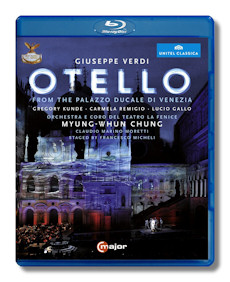
The Internet's Premier Classical Music Source
Related Links
- Verdi Reviews
- Latest Reviews
- More Reviews
-
By Composer
-
Collections
DVD & Blu-ray
Books
Concert Reviews
Articles/Interviews
Software
Audio
Search Amazon
Recommended Links
Site News
 Blu-ray Review
Blu-ray Review
Giuseppe Verdi

Otello
- Otello - Gregory Kunde
- Desdemona - Carmella Remigio
- Iago - Lucio Gallo
- Emilia - Elizabetta Martorana
- Cassio - Francesco Marsiglia
- Roderigo - Antonello Ceron
- Lodovico Mattia Denti
- Montano - Matteo Ferrara
- Un Araldo - Antonio Casagrande
Chorus of the Teatro La Fenice
Orchestra of the Teatro La Fenice/Myung-Whun Chung
Recorded Live at the Ducal Palace, Venice - July 10, 2013
Stage Director - Francesco Micheli
Set Designer - Edoardo Sanchi
Costume Designer - Silvia Aymonino
Unitel Classica/C Major Blu-ray 716604 149m LPCM Stereo DTS-HD Master Audio
Also available on DVD 716508: Amazon - UK - Germany - Canada - France - Japan
This is a quite lavish production of Otello that should, for the most part, please both traditionalists and progressives. The performance is a live one that took place in the courtyard of the Palazzo Ducale in Venice, an open air setting used for this production by the Teatro La Fenice. Thus the background on stage is comprised of a huge pillared multi-sided building of Gothic- and Renaissance-style architecture, with statues and ornate balconies and a huge magnificent stairway. Against these are light projections that show, depending on the action in the story, Otello's ship in stormy waters, animals (a slithering snake when Iago is plotting mischief), religious imagery, and much else, including glittering speckles or waves of light. In general sets on the stage floor are often sparse but appropriate, though Otello's quarters are given rather exotic furnishings of a Middle Eastern character.
Costumes for the female characters seem appropriate for the style of the period (late 15th-century Venetian Cypress), but the sailor's white uniforms are more 19th century in appearance. Actually, they look like naval dress uniforms or almost as if every sailor is an officer on the ship. The orchestra is situated to the left of the stage action, not in front of it, allowing some scenes to be shot with the orchestra clearly in view. A walkway on the outer left of the stage allows characters to walk alongside the full length of the orchestra pit. Thus, the treatment here by Stage Director Francesco Micheli can be called traditional in many ways, while at the same time incorporating many modern and innovative techniques. What may be mildly controversial here is that Desdemona and Otello come to life after the latter's death scene and walk off to…somewhere. The afterlife?
The performances by the singers are quite fine. The two leads, Gregory Kunde as Otello and Carmela Remigio as Desdemona, are both splendid. Kunde is an imposing presence on stage and has a powerful voice and good dramatic skills. Try his death scene number from Act 4, Niun mi tema, where his anguish and sorrow become almost palpable in their intensity. Carmela Remigio has a slightly more delicate voice but enough power to project when called for. Hear her subtly delivered Piangea cantando nell'erma landa from Act 4, as well as the ensuing Ave Maria, highlights both from this performance. The two singers are excellent together as well: try their closing number from Act 1, Gia nella notte densa, wherein both deliver heartfelt and intense performances of the highest artistry. Veteran baritone Lucio Gallo makes makes a deliciously villainous Iago. He never overplays his character's evildoings but always remains subtle in bringing them off. The rest of the cast is splendid. Conductor Myung-Whun Chung, always maintains a fine sense for the appropriate tempo and for subtle phrasing, and he draws fine playing from the orchestra and committed singing from the chorus.
The camera work and picture quality are fine, and despite the outdoor venue the sound reproduction is very good though voices tend to sound a bit less resonant. Overall, this is a splendid production of Otello that scores high on almost every count. In 2003 I reviewed an excellent Otello that featured Placido Domingo and Barbara Fritolli in the leads, with Muti conducting (TDK DVD DVOPOTEL). There is also a solid 2006 effort on a double-DVD from Opus Arte featuring as the leads Jose Cura and Krassimira Stoyanova, with a young Vittorio Grigolo as Cassio. Strong as the Domingo is, that production's Iago is Leo Nucci, who is also quite fine but perhaps just a bit over-the-top dramatically. The Jose Cura on Opus Arte was also a good rendition of the opera but was somewhat limited by relatively modest production values. Thus, I would give this new effort from Unitel Classica/C Major the edge over the other two and rank it among the best video recordings of Otello now available. Highly recommended.
Copyright © 2014, Robert Cummings


















